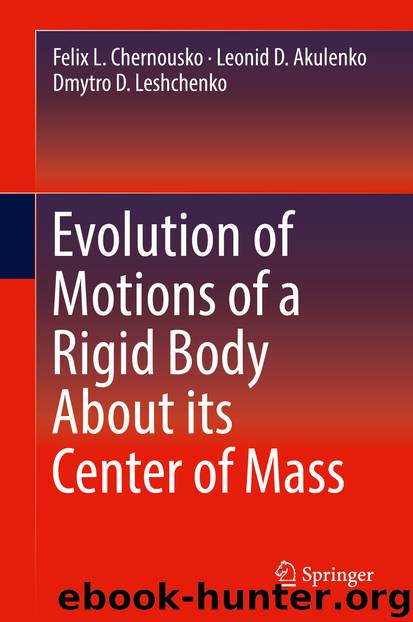Evolution of Motions of a Rigid Body About its Center of Mass by Felix L. Chernousko Leonid D. Akulenko & Dmytro D. Leshchenko

Author:Felix L. Chernousko, Leonid D. Akulenko & Dmytro D. Leshchenko
Language: eng
Format: epub
Publisher: Springer International Publishing, Cham
(5.86)
The first equality in (5.83) assumes the form:
(5.87)
Differentiating equality (5.87), we conclude that the k-th derivative ω (k) will be, up to the terms of the order of ε 2, a homogeneous polynomial of degree k + 1 of the components of vector ω, where k = 0 , 1 , ….
In the first example (R 0 ≡ 0), we conclude from the first equality (5.85) that are homogeneous polynomials of ω of the second degree having the order of m 0 lω 2. Here, m 0 is the characteristic mass of points P i , and l is the characteristic linear dimension of the order of ρ i .
Then it follows from (5.80) that q is the sum of homogeneous polynomials of ω of the second and third degrees having the order of m 0 lc −1 ω 2 and m 0 lc −2 bω 3, respectively. Here, c is the characteristic stiffness of elastic couplings (of the order of elements of matrix C), and b is the characteristic dissipation coefficient (of the order of elements of matrix B). The vectors r i , i = 1 , … , N, defined by formula (5.54), have the same structure. Note that, according to (5.87), each differ entiation increases the degrees of polynomials of ω by one. Therefore, vector μ from (5.85) for R 0 ≡ 0 is the sum of homogeneous polynomials of the fourth and fifth degrees of components ω j of vector ω, namely:
Download
This site does not store any files on its server. We only index and link to content provided by other sites. Please contact the content providers to delete copyright contents if any and email us, we'll remove relevant links or contents immediately.
| Automotive | Engineering |
| Transportation |
Whiskies Galore by Ian Buxton(41523)
Introduction to Aircraft Design (Cambridge Aerospace Series) by John P. Fielding(32881)
Small Unmanned Fixed-wing Aircraft Design by Andrew J. Keane Andras Sobester James P. Scanlan & András Sóbester & James P. Scanlan(32567)
Craft Beer for the Homebrewer by Michael Agnew(17926)
Turbulence by E. J. Noyes(7690)
The Complete Stick Figure Physics Tutorials by Allen Sarah(7134)
Kaplan MCAT General Chemistry Review by Kaplan(6582)
The Thirst by Nesbo Jo(6431)
Bad Blood by John Carreyrou(6270)
Modelling of Convective Heat and Mass Transfer in Rotating Flows by Igor V. Shevchuk(6218)
Learning SQL by Alan Beaulieu(6023)
Weapons of Math Destruction by Cathy O'Neil(5818)
Man-made Catastrophes and Risk Information Concealment by Dmitry Chernov & Didier Sornette(5638)
Digital Minimalism by Cal Newport;(5382)
Life 3.0: Being Human in the Age of Artificial Intelligence by Tegmark Max(5181)
iGen by Jean M. Twenge(5149)
Secrets of Antigravity Propulsion: Tesla, UFOs, and Classified Aerospace Technology by Ph.D. Paul A. Laviolette(4972)
Design of Trajectory Optimization Approach for Space Maneuver Vehicle Skip Entry Problems by Runqi Chai & Al Savvaris & Antonios Tsourdos & Senchun Chai(4837)
Electronic Devices & Circuits by Jacob Millman & Christos C. Halkias(4739)
